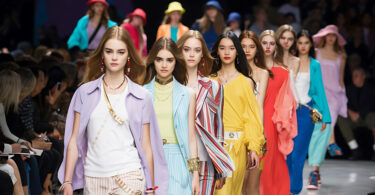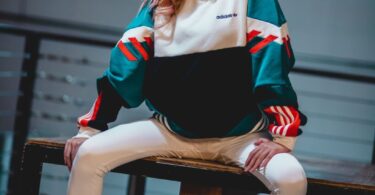Exploring Asian Streetwear Fashion

Introduction

Street fashion in Asia has become a global phenomenon.
Especially with countries like Korea, Japan, China, Hong Kong, and Thailand making their mark in the streetwear scene.
This article delves into the different types of Asian streetwear fashion and highlights the latest trends.
It also going to examine the history of the movement, and provides shopping suggestions for those interested in exploring this unique style.
So let’s get started …
The History of Asian Streetwear

Japan:
Japanese streetwear traces its roots back to the 1960s and 1970s with rebellious fashion styles emerging in youth subcultures like the “zoku” and the “Bosozoku.”
The Harajuku district in Tokyo became a hub for alternative fashion and street style in the 1980s and 1990s.
With brands like A Bathing Ape (BAPE) and Comme des Garçons, it gained global recognition.
South Korea:
Korean streetwear gained popularity in the 1990s and early 2000s alongside the rise of K-pop and Korean entertainment.
Korean celebrities and idols influenced the development of unique streetwear styles, blending casual and sporty elements with trendy and fashionable looks.
China:
Chinese streetwear emerged more recently, experiencing significant growth in the 2000s.
The rise of the Chinese middle class and increased access to global fashion trends contributed to the fusion of traditional cultural elements with modern fashion in Chinese streetwear.
Hong Kong:
Influenced by Western fashion trends due to its history as a former British colony.
Hong Kong’s streetwear culture began to develop in the 1980s and 1990s, influenced by hip-hop and skateboarding subcultures.
Hong Kong streetwear showcases an urban and cosmopolitan style, often incorporating high-end designer brands.
Other Asian Countries:
Streetwear scenes in countries like Thailand, Indonesia, and Malaysia have also seen significant growth in recent years.
Local brands, social media influencers, and a growing interest in fashion have contributed to the development of unique streetwear styles in these countries.
Types of Asian Streetwear Fashion

Japanese Streetwear:
Japanese streetwear is known for its avant-garde and eclectic styles, often incorporating elements of anime and manga.
Popular brands like Comme des Garçons, A Bathing Ape (BAPE), and Neighborhood have contributed to the popularity of Japanese streetwear.
Korean Streetwear:
Korean streetwear combines high fashion with casual and trendy styles.
It often features oversized and layered clothing, vibrant colors, and unique accessories.
Brands like Ader Error, Gentle Monster, and Stylenanda have gained recognition in the Korean streetwear scene.
Chinese Streetwear:
Chinese streetwear draws inspiration from traditional Chinese culture while embracing modern and urban aesthetics.
It often incorporates elements of calligraphy, embroidery, and Chinese symbols into contemporary designs.
Brands like Li-Ning, SANKUANZ, and PRONOUNCE represent Chinese streetwear on the global stage.
Hong Kong Streetwear:
Hong Kong streetwear combines Western influences with Hong Kong’s urban style.
It often features minimalist designs, clean lines, and a mix of streetwear and high fashion elements.
Brands like CLOT, Izzue, and b+ab are popular in Hong Kong’s streetwear scene.
Thai Streetwear:
Thai streetwear showcases a mix of traditional Thai elements and modern urban style.
It often incorporates bold prints, vibrant colors, and street-inspired silhouettes.
Brands like Flynow, Sretsis, and Dry Clean Only have contributed to the rise of Thai streetwear.
Singaporean Streetwear:
Singaporean streetwear embraces a blend of international influences and local aesthetics.
It often features clean and contemporary designs, with a focus on functionality and comfort.
Brands like Depression, MASH-UP, and COLLATE have made a mark in the Singaporean streetwear scene.
The Latest Asian Streetwear Trends and How to Achieve Them

Korean Streetwear Trends:
- Oversized silhouettes
- Mix and match contrasting styles and elements
- Retro vibes and vintage-inspired pieces
- Pastel colors and soft, feminine aesthetics
- Logomania and brand-focused fashion
- Athleisure and sporty elements
- Statement accessories
Japanese Streetwear Trends:
- Avant-garde and experimental fashion
- Unique and unconventional silhouettes
- Streetwear subcultures like Harajuku, Gyaru, and Visual Kei
- Bold patterns and vibrant colors
- Playful and kawaii (cute) aesthetics
- Emphasis on individualism and self-expression
- Layering and mixing different styles
Chinese Streetwear Trends:
- Fusion of traditional Chinese elements with modern fashion
- Bold and eye-catching designs
- Cultural motifs and Chinese symbols
- Streetwear inspired by Chinese history, art, and literature
- Mixing traditional garments with contemporary pieces
- Influences from Chinese pop culture and street style
Hong Kong Streetwear Trends:
- Urban and cosmopolitan fashion
- Sleek and polished looks
- Tailored and well-fitted garments
- Minimalist color palettes with pops of color
- Influences from Western streetwear and high fashion
- Emphasis on quality materials and craftsmanship
- A mix of streetwear and high-end designer brands
Thai Streetwear Trends:
- Vibrant and colorful fashion
- Traditional Thai elements and motifs
- Streetwear influenced by Thai street culture and the music scene
- Relaxed and comfortable silhouettes
- Bold prints and patterns
- Emphasis on accessories and jewelry
- Influence from international streetwear trends with a local twist
To achieve these streetwear styles, immerse yourself in the culture and fashion scenes of each country.
Follow local influencers, explore local brands and designers, and pay attention to street style trends.
Experiment with mixing and matching different styles, incorporate cultural elements and embrace individuality in your fashion choices.
Examples of Street Fashion in Each Asian Country

Korean Street Fashion:
- K-Fashion with oversized silhouettes, layering, and bold colors influenced by K-pop idols and celebrities.
Japanese Street Fashion:
- Harajuku style with eclectic and creative combinations, including subcultures like Lolita, Visual Kei, and Gyaru.
Chinese Street Fashion:
- Streetwear with traditional elements, blending cheongsam-inspired dresses and Chinese motifs with modern styles.
Hong Kong Street Fashion:
- Urban and high-fashion styles, combine streetwear with high-end designer brands for a polished and sophisticated look.
Thai Street Fashion:
- Retro and bohemian fashion, embracing vibrant prints, flowing maxi dresses, and unique combinations of textures and patterns.
Where to Shop for Asian Streetwear Fashion

Online Retailers:
- YesStyle
- StyleNanda
- Rakuten
- Taobao
Local Boutiques and Stores:
- Explore areas with significant Asian populations or cultural influence for local boutiques and stores specializing in Asian streetwear.
Asian Streetwear Brands:
- A Bathing Ape (Japanese)
- 3.1 Phillip Lim (Chinese-American)
- AAPE by A Bathing Ape (Korean)
- Chuu (Korean)
- X-girl (Japanese)
- CLOT (Hong Kong)
Street Markets and Flea Markets:
- Visit local street markets and flea markets in Asian countries for a wide range of fashion options.
Secondhand and Vintage Stores:
- Explore online and offline secondhand and vintage stores for unique and one-of-a-kind Asian streetwear pieces.
Remember to check availability and shipping options based on your location.
Consider supporting local designers and artists by exploring independent boutiques and small-scale fashion businesses.
Last thoughts:
In conclusion, Asian streetwear fashion is a dynamic and ever-evolving blend of cultural influences, global trends, and individual expression.
From the vibrant and eclectic styles of Harajuku in Japan to the trendy and K-pop-inspired looks of South Korea,
each country in Asia brings its own unique flavor to the world of street fashion.
Embrace the creativity, diversity, and innovation found within Asian streetwear, and let it inspire your personal style journey.







